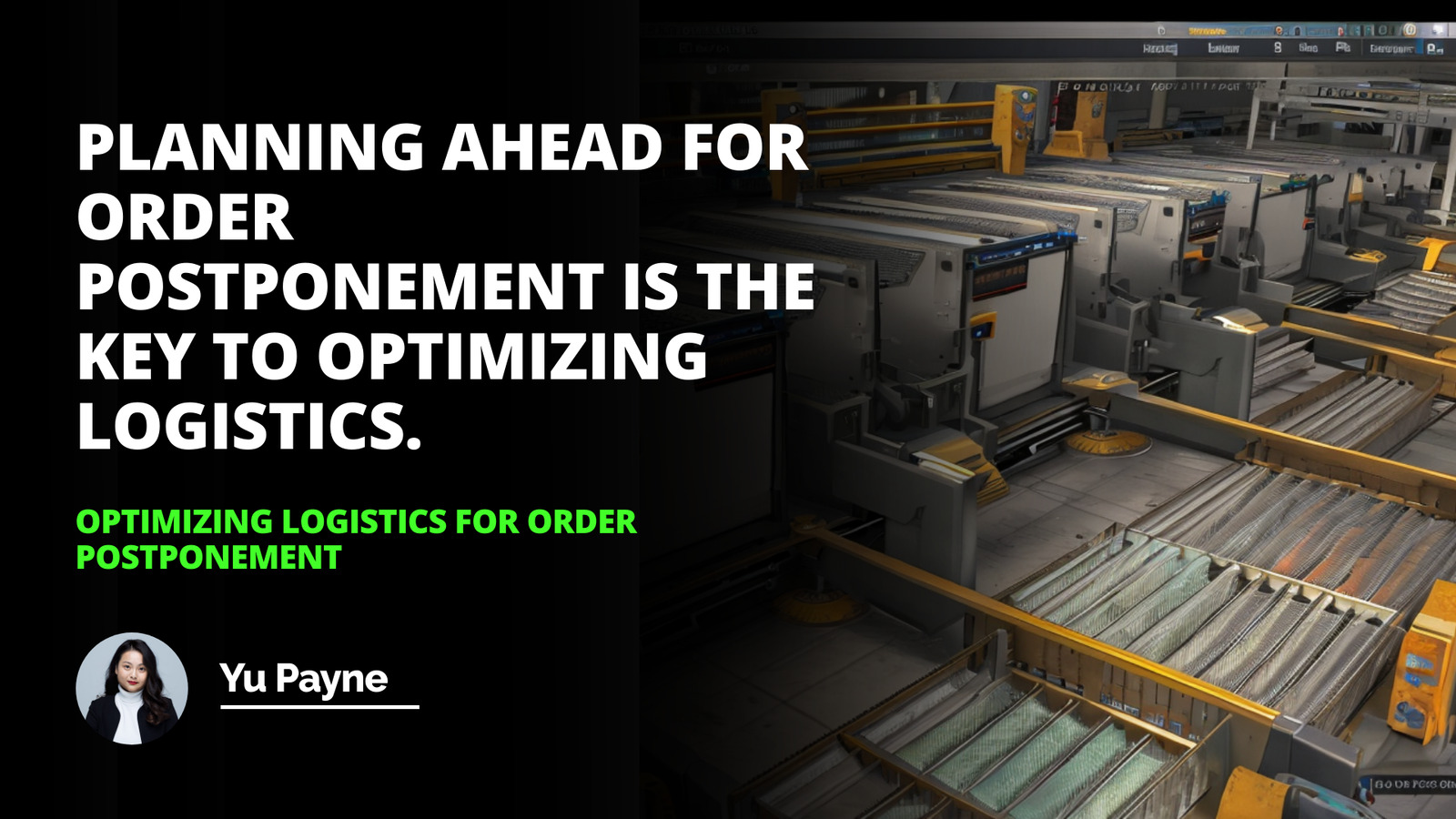
Understanding the Power of Product Substitutes in Logistics Management
I've always been fascinated by the intricate dance that is logistics management. Growing up, my uncle ran a small grocery store in our hometown, and I spent countless summers helping out. One summer, a major supplier couldn't deliver our usual brand of flour due to unexpected manufacturing issues. My uncle, ever the resourceful businessman, decided to stock a different brand. To our surprise, not only did the customers accept the substitute, but many preferred it over the original. That early lesson taught me the significance of product substitutes—not just in keeping the shelves stocked but in enhancing customer satisfaction.
Introduction: Logistics Mgmt & Customer Service
Product Substitutes: An Overview
Benefits of Product Substitutes
Challenges of Product Substitutes
Conclusion
Introduction: Logistics Management & Customer Service
In the sprawling world of supply chains and logistics, the ability to adapt is key. Logistics management isn't just about moving goods from point A to point B; it's about ensuring that customers receive what they need, when they need it, and in the best possible condition. Equally important is customer service, which bridges the gap between logistical operations and customer expectations. The fusion of these two elements is where product substitutes come into play, offering a strategic avenue to optimize the supply chain management process.
Product Substitutes: An Overview
So, what exactly are product substitutes? Simply put, they are alternative products offered to customers when the original item is unavailable. These substitutes are similar or even superior in terms of quality, size, or brand. In the dynamic landscape of supply chains, disruptions are almost inevitable—be it due to manufacturing hiccups, quality issues, or unforeseen events like natural disasters. Offering a product substitute becomes a proactive strategy to mitigate these challenges.
I recall a case during my tenure at a major retail chain. We faced a shortage of a popular electronic gadget right before the holiday season. Instead of turning customers away, we offered a substitute with better features at a comparable price. Not only did this move salvage potential lost sales, but it also enhanced customer goodwill.
Uniting Engineering And Procurement For Efficient Supply Chain Management
Standardizing Logistics To Unlock Agility And Responsiveness
Benefits of Product Substitutes
The advantages of incorporating product substitutes into your logistics strategy are manifold:
1- Cost Reduction: By substituting products that are more readily available or less expensive to produce, companies can reduce production and shipping costs.
2- Customer Retention: Offering substitutes prevents customers from walking away due to unavailable products, thereby maintaining loyalty.
3- Enhanced Customer Satisfaction: Sometimes, the substitute might be a superior product, leading to increased customer delight.
4- Inventory Flexibility: Substitutes allow for better inventory management, reducing the risks associated with overstocking or stockouts.
5- Brand Image Improvement: Demonstrates a company’s commitment to meeting customer needs, bolstering its reputation.
I'll never forget a story shared by a colleague who managed logistics for a global footwear brand. They once had a supply chain disruption for a particular sneaker model. By offering a substitute model that was eco-friendly, they not only met customer demand but also aligned with growing consumer preferences for sustainable products. This move significantly boosted their brand image.
The key to successful logistics management is to ensure customer satisfaction through creative product substitution.
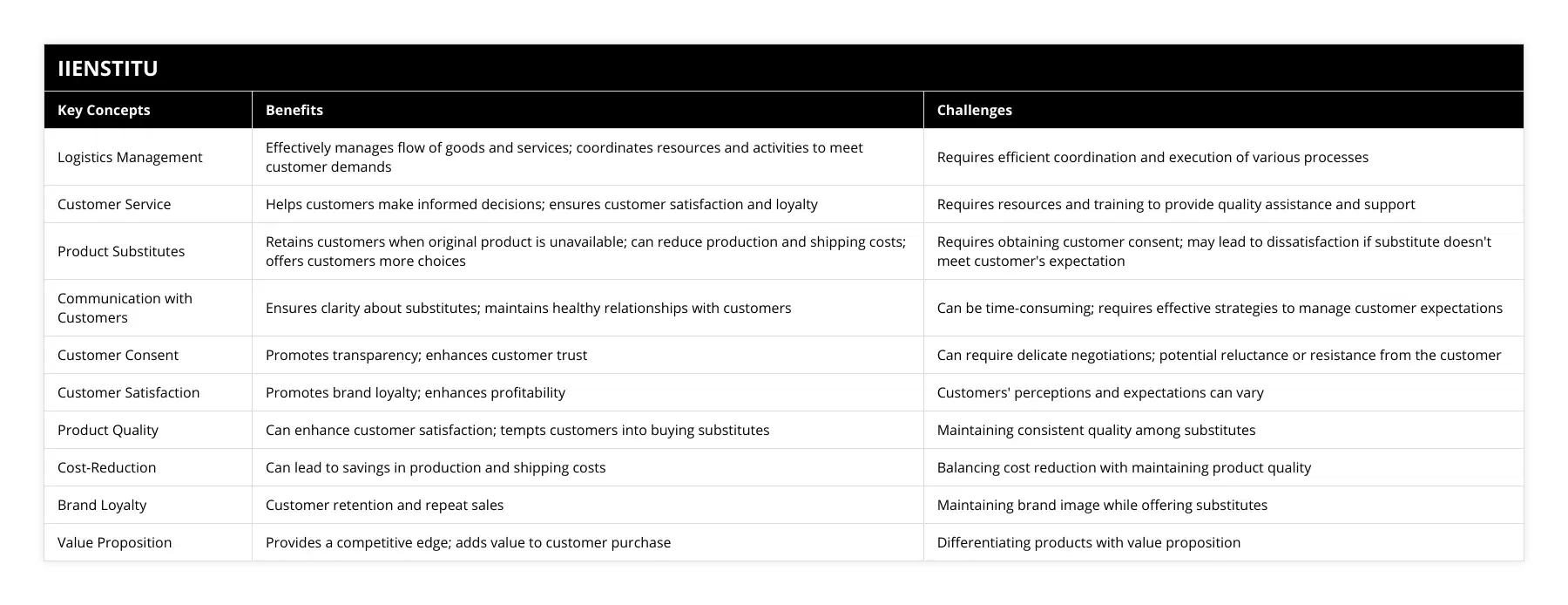
Challenges of Product Substitutes
However, it's not all smooth sailing. Implementing product substitutes comes with its own set of challenges:
Customer Consent: Gaining customer approval for a substitute product requires clear communication. Customers need to understand why the original product is unavailable and why the substitute is a suitable alternative.
Satisfaction Assurance: There's always the risk that the substitute won't meet the customer's expectations, leading to dissatisfaction.
Operational Complexity: Managing substitutes can add layers of complexity to inventory and supply chain management.
Legal Implications: In some cases, substituting products without explicit consent can lead to legal issues, especially if the substitute differs significantly from the original.
Tips to Optimize the Supply Chain Management Process
To effectively navigate these challenges and optimize supply chain management process tips, consider the following strategies:
Transparent Communication: Always inform customers about the unavailability of the original product and provide detailed information about the substitute.
Ensure Quality Parity or Improvement: The substitute should be of equal or better quality to avoid disappointing the customer.
Train Customer Service Teams: Equip your customer-facing staff with the right information and training to handle queries about substitutes effectively.
Feedback Mechanisms: Implement systems to gather customer feedback on substitutes to continually improve the process.
Legal Compliance: Ensure all substitutions comply with relevant laws and regulations to avoid any legal complications.
I once consulted for a company that specialized in gourmet foods. They had to substitute an ingredient in their signature product due to a supply issue. By proactively reaching out to their loyal customers, explaining the situation, and even offering a small discount, they managed to maintain trust and satisfaction.
Real-world Examples
In the food industry, product substitution is common, especially with seasonal items. For instance, if a particular type of berry is out of season, a bakery might substitute it with another fruit in their pies. Similarly, in the automotive industry, if a specific part is unavailable, a manufacturer might use an alternative that meets the required specifications.
The Role of Technology
Modern technology plays a pivotal role in managing product substitutes. Advanced inventory management systems can:
Alert managers to potential stockouts, allowing for timely substitution decisions.
Provide real-time data on available substitutes across different warehouses.
Integrate with customer relationship management (CRM) systems to personalize substitution offers based on customer preferences.
Strategic Considerations
When integrating product substitutes into your logistics strategy, consider the following:
1- Customer Segmentation: Understand which customer segments are more open to substitutes.
2- Brand Alignment: Ensure that substitutes align with your brand values and customer expectations.
3- Supply Chain Partnerships: Develop strong relationships with suppliers who can offer reliable substitutes when needed.
Conclusion
The world of logistics and customer service is ever-evolving. Product substitutes offer a valuable strategy to navigate supply chain disruptions, reduce costs, and enhance customer satisfaction. By following these optimize supply chain management process tips, companies can turn potential setbacks into opportunities for growth and customer loyalty.
Reflecting back to those days in my uncle's store, I realize that the principles remain the same, even in today’s complex supply chains. It's about being resourceful, putting the customer first, and finding creative solutions to unexpected problems.
References
Chopra, S., & Meindl, P. (2016). Supply Chain Management: Strategy, Planning, and Operation. Pearson.
Christopher, M. (2016). Logistics & Supply Chain Management. Pearson UK.
Coyle, J. J., Langley, C. J., Novack, R. A., & Gibson, B. J. (2016). Supply Chain Management: A Logistics Perspective. Cengage Learning.
Bowersox, D. J., Closs, D. J., & Cooper, M. B. (2013). Supply Chain Logistics Management. McGraw-Hill.
Rushton, A., Croucher, P., & Baker, P. (2014). The Handbook of Logistics and Distribution Management. Kogan Page Publishers.
Frequently Asked Questions
What are the benefits of using product substitutes to improve customer service in logistics management?
Logistics management is a key component of the modern business world, as it is essential to the success of a company’s operations. Product substitutes are a valuable tool for improving customer service in logistics management, as they can help to reduce costs and increase efficiency. This article will explore the benefits of using product substitutes in logistics management and how they can be used to improve customer service.
One of the most significant benefits of product substitutes is that they can help to reduce costs. By using product substitutes, companies can save money on their supply chain costs by purchasing alternative products that are similar in quality to their original product but at a lower cost.
This can help reduce overhead costs and improve margins, allowing companies to be more competitive in pricing. Moreover, using product substitutes can also help to reduce waste, as companies can purchase alternative products that are better suited to their needs instead of purchasing additional products that will not be used.
Another significant benefit of product substitutes is that they can help improve logistics management efficiency. Companies can use product substitutes to reduce the time and effort required to source, store, and transport products.
This can lead to improved delivery times and lower shipping costs, resulting in improved customer service and satisfaction. In addition, product substitutes can also reduce the risk of stockouts, as companies will have multiple options for sourcing products, allowing them to quickly find a suitable alternative in the event of a shortage.
Finally, product substitutes can also help to improve customer service by simplifying product selection. Having multiple options for a given product allows customers to easily find the product that best meets their needs and preferences. This can help to improve customer satisfaction, as customers will feel more confident in their product selection and be more likely to make repeat purchases.
In conclusion, product substitutes can be a valuable tool for improving customer service in logistics management. By using product substitutes, companies can reduce costs, improve efficiency, and simplify product selection, all of which can help to improve customer service and satisfaction.

What challenges should be considered when implementing product substitutes in logistics management?
Logistics management is an intricate process that requires careful consideration when making decisions. One of the critical considerations is the implementation of product substitutes in the supply chain. Product substitutes are products that can be substituted for the original product when it is not available. This practice has numerous benefits, including cost savings, improved product availability, and increased flexibility. However, several challenges must be addressed to ensure a successful implementation.
First, there must be a clear understanding of the needs and expectations of the customer. The customer must be aware of the substitute product and its characteristics before its introduction in the supply chain. This will allow the customer to make an informed decision and ensure that the substitute product meets their needs.
Second, the substitute product must be of sufficient quality. To maintain customer satisfaction, the substitute product must be of the same quality as the original product. If not, it could lead to dissatisfaction and negatively impact the business's reputation.
Third, the substitute product must be available in the desired quantities. This can be a challenge, as the availability of substitute products is often limited. It is essential to ensure that the substitute product is readily available to meet customer demand.
Finally, the costs associated with the substitute product must be considered. The price of the substitute product may be higher than the original product, and the cost of logistics management must also be considered.
In conclusion, product substitutions can offer numerous benefits to the logistics management process. However, it is essential to consider the challenges outlined above to ensure a successful implementation. By doing so, businesses can improve customer satisfaction, reduce costs, and improve product availability.
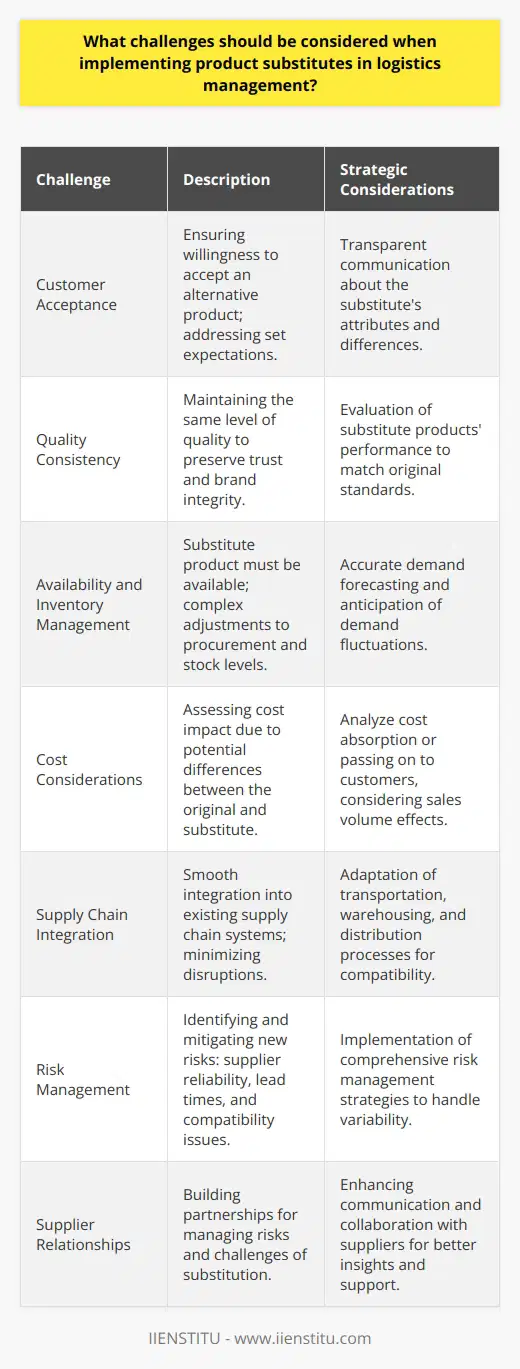
How can product substitutes be used to enhance customer service in logistics management?
Logistics management is a key element to successful customer service, and product substitutes are an effective tool to enhance this process. Product substitutes refer to the use of alternative products to meet customer needs in case of a product shortage or disruption in the supply chain. By relying on product substitutes, businesses can continue to meet their customers’ needs even when their primary product is unavailable.
Product substitutes can reduce customer service issues associated with shortages or supply chain disruptions. For example, when a customer orders a product that is not available, the business can offer an alternative product as a substitute.
This can help to minimize customer frustration and ensure that the customer’s needs are met promptly. Additionally, product substitutes can reduce the risk of lost sales due to product shortages or supply chain disruptions. By having a variety of product substitutes available, businesses can reduce the risk of lost sales and ensure that their customers have access to the products they need.
Product substitutes can also be used to improve customer service in logistics management. By offering product substitutes, businesses can provide customers with a more personalized experience. For example, businesses can offer customers the option to select from various product substitutes to meet their needs. Additionally, product substitutes can be used to create a more efficient logistics process. By offering product substitutes, businesses can reduce the time and cost associated with fulfilling customer orders.
Finally, product substitutes can also be used to improve customer satisfaction. By offering product substitutes, businesses can ensure that their customers receive the products they need promptly. Additionally, product substitutes can create a more personalized customer experience by offering customers the ability to choose from various product substitutes.
Overall, product substitutes are an effective tool to enhance customer service in logistics management. Businesses can reduce customer service issues associated with product shortages or supply chain disruptions by relying on product substitutes. Additionally, product substitutes can improve customer satisfaction and create a more efficient logistics process. As such, product substitutes are an effective tool to enhance customer service in logistics management.
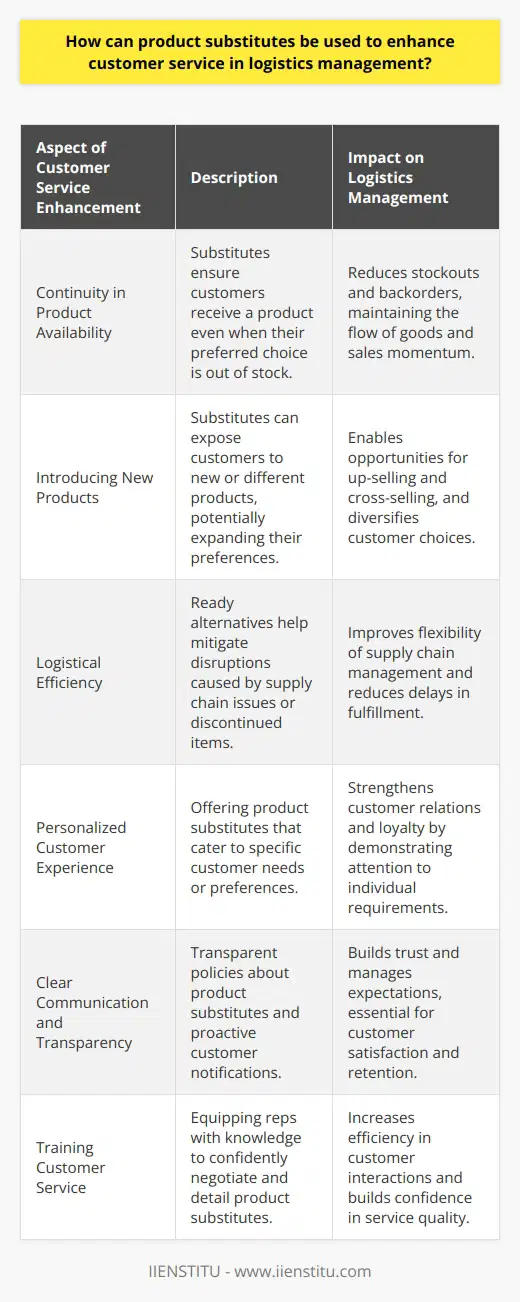
How does logistics management improve customer satisfaction by reducing lead times and increasing product availability?
**Importance of Logistics Management**
Logistics management plays a crucial role in enhancing customer satisfaction by minimizing lead times and maximizing product availability. Through efficient management of various logistical operations, organizations can ensure timely delivery of products to their customers, which is directly proportional to overall customer contentment.
**Lead Time Reduction**
Lead time is a critical factor in a customer's decision-making process, as it indicates the duration between placing an order and receiving the product. Effective logistics management reduces lead times by optimizing transportation routes, maintaining a reliable inventory system, and using data-driven forecasting to anticipate demand. As a result, products reach consumers faster, contributing to satisfied and loyal customers.
**Product Availability**
Ensuring a product's availability plays a vital role in facilitating customer satisfaction. Logistics management directly impacts product availability by managing various elements in the supply chain, including procurement, transportation, warehousing, and inventory management. By maintaining appropriate inventory levels, organizations can prevent stockouts that may lead to customer dissatisfaction and lost sales. Moreover, improved product availability through logistics management can help companies gain a competitive edge in the market.
**Data-driven Decision Making**
Logistics management relies heavily on accurate and timely data to make informed decisions that streamline operations and enhance customer satisfaction. Advanced technologies, such as artificial intelligence and machine learning, enable organizations to process large amounts of data to identify trends, patterns, and potential bottlenecks in the supply chain. This allows for improved forecasting, demand planning, and inventory management, which subsequently leads to reduced lead times and increased product availability.
**A Continuous Improvement Process**
Logistics management is an ongoing process that aims to optimize supply chain operations continually. By monitoring key performance indicators (KPIs), maintaining open communication channels, and promoting a culture of continuous improvement, organizations can enhance their logistics management capabilities. This, in turn, supports reduced lead times and increased product availability, ultimately boosting customer satisfaction.
In conclusion, logistics management is an essential component of a company's overall success, as it directly influences customer satisfaction. By reducing lead times and increasing product availability, logistics management ensures customers receive their desired products promptly and efficiently. The continuous improvement approach adopted in logistics management fosters a culture that values customer satisfaction and promotes long-term business growth.

What role does effective communication play in enhancing customer service within supply chain management?
Role of Effective Communication
Effective communication plays a crucial role in enhancing customer service within supply chain management by streamlining operations, improving collaboration, and fostering transparency. In an interconnected and complex supply chain ecosystem, companies must constantly exchange information with various stakeholders, such as suppliers, manufacturers, logistics providers, and end customers.
Streamlining Operations
Efficient communication accelerates the flow of information, ensuring timely order fulfillment, reducing lead times, and minimizing inventory costs. By promptly addressing issues, companies can alleviate disruptions and mitigate risks, ultimately improving their responsiveness to market demands and customer expectations.
Improving Collaboration
Strengthening relationships among stakeholders is a key aspect of customer service in supply chain management. Effective communication fosters trust and cooperation between parties, as it facilitates problem-solving and enables a seamless flow of goods and services. When communication channels function optimally, businesses can proactively identify and address challenges that could negatively impact the customer experience.
Fostering Transparency
Information sharing is vital for reinforcing transparency in supply chain processes. Transparent communication practices enable companies to monitor performance, predict potential issues and optimize processes. This, in turn, allows businesses to provide accurate, real-time information to customers regarding product availability, delivery status, and potential delays. By keeping customers informed, organizations can effectively manage expectations and maintain customer satisfaction.
In conclusion, effective communication bears substantial significance for enhancing customer service within supply chain management. By streamlining operations, improving collaboration, and fostering transparency, businesses can bolster efficiency and consistently meet customer demands. A strong communication framework allows organizations to cope with potential challenges while building lasting relationships with customers and stakeholders, ensuring long-term business success.
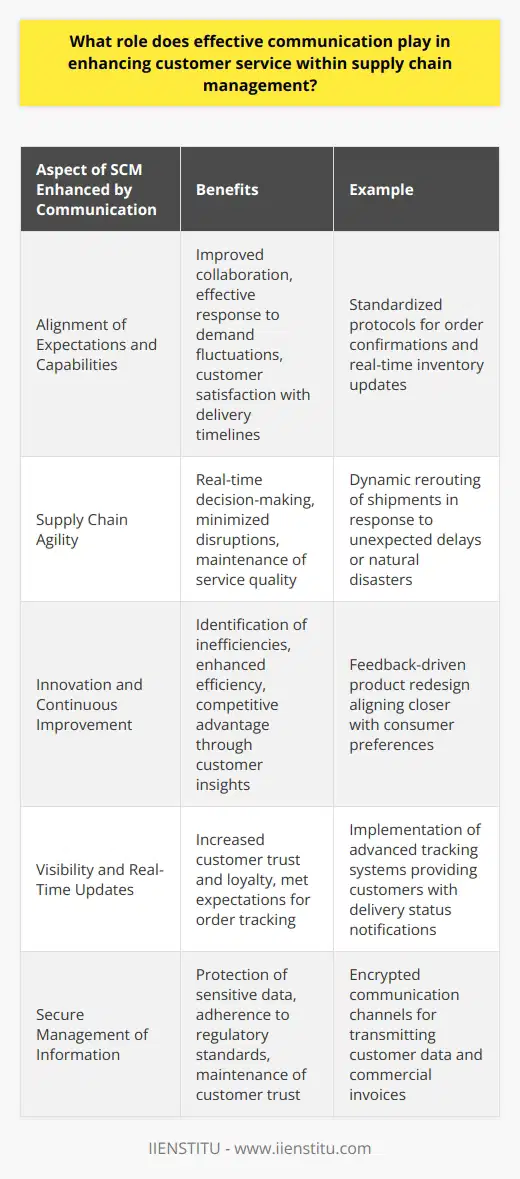
What are the key elements of a successful logistics and supply chain strategy for ensuring consistent and reliable customer service?
Effective Communication and Collaboration
A successful logistics and supply chain strategy must prioritize effective communication and collaboration among all stakeholders. This involves fostering a culture of information sharing, transparency, and cooperation among suppliers, manufacturers, and retailers to ensure seamless and efficient flow of goods and services.
Alignment of Goals and Objectives
For a consistent and reliable customer service, businesses must align their logistics and supply chain goals and objectives with those of their customers. Ensuring that customer needs and preferences are met while maintaining operational efficiency is key to meeting service level expectations and maximizing customer satisfaction.
Adopting Technology and Automation
Incorporating modern technology and automation into logistics and supply chain processes can significantly streamline operations and improve customer service. Real-time inventory management, automated order fulfillment, and advanced forecasting tools can help businesses anticipate customer needs and allocate resources more efficiently, ensuring timely delivery to customers.
Resilient and Flexible Supply Chain Network
A successful logistics and supply chain strategy should be resilient and flexible to changes in market conditions and customer preferences. Building contingency plans and incorporating multiple suppliers, transportation options, and warehousing solutions can help businesses minimize disruptions and maintain consistent and reliable customer service, even during unexpected events and fluctuations.
Performance Measurement and Continuous Improvement
Monitoring and measuring performance in the logistics and supply chain operations is crucial to maintaining high customer service standards. Regularly reviewing key performance indicators, such as on-time delivery, order accuracy, and inventory turnover, allows businesses to identify areas for improvement and implement corrective actions when needed. In addition, encouraging a culture of continuous improvement and innovation helps drive long-term customer service enhancements.
In conclusion, ensuring consistent and reliable customer service in the logistics and supply chain requires a strategy focused on effective communication and collaboration, alignment of goals and objectives, adoption of technology and automation, a resilient and flexible network, and performance measurement and continuous improvement. By integrating these key elements, businesses can optimize their logistics and supply chain operations and deliver exceptional customer service.

How can logistics management contribute to the enhancement of customer service through effective demand forecasting and inventory management?
Demand Forecasting in Logistics Management
One significant way logistics management can contribute to improved customer service is through accurate demand forecasting. By examining historical sales data, seasonal trends, and other relevant information, businesses can anticipate customer needs, allowing them to optimize production scheduling, transportation, and storage of goods. Accurate demand forecasting prevents overstock or stockouts, leading to fewer delays, reduced costs, and improved customer satisfaction.
Inventory Management and Customer Service
In addition to demand forecasting, effective inventory management plays a vital role in enhancing customer service. Adopting inventory control strategies, such as Just-In-Time (JIT) or Vendor Managed Inventory (VMI) systems, allows businesses to maintain the optimal level of inventory and minimize storage costs. Efficient inventory management ensures that products are available when customers need them, which enhances the overall customer experience.
Role of Technology in Demand Forecasting and Inventory Management
Technology plays a crucial role in streamlining demand forecasting and inventory management processes. Advanced software solutions, such as ERP and WMS systems, allow businesses to collect, analyze, and use data to make informed decisions regarding production, transportation, and inventory control. Furthermore, the use of AI and machine learning algorithms enables more accurate demand predictions, leading to better operational efficiency and improved customer services.
In conclusion, effective demand forecasting and inventory management in logistics management can greatly enhance customer service. By accurately anticipating customer needs and maintaining optimal inventory levels, businesses can ensure timely product availability, reduce costs, and ultimately, exceed customer expectations. The implementation of advanced technologies further enables businesses to optimize their logistics processes, leading to even greater levels of customer satisfaction.

What are the main strategies for improving customer satisfaction and loyalty through efficient supply chain management and logistics practices?
Effective Communication and Collaboration
One of the main strategies for improving customer satisfaction and loyalty through efficient supply chain management and logistics practices is establishing effective communication and collaboration among all partners involved. This includes sharing accurate and timely information, addressing potential problems or bottlenecks, and implementing scalable processes to meet consumer demands.
Inventory Management and Visibility
Moreover, ensuring proper inventory management and visibility across the supply chain is another essential factor for satisfaction and loyalty improvement. By implementing advanced inventory control systems, businesses can minimize stockouts, reduce lead times, and react promptly to any market fluctuations. This results in a more seamless customer experience and fosters long-term loyalty.
Order and Delivery Accuracy
Prioritizing order and delivery accuracy can also significantly impact customer satisfaction and brand loyalty. This means investing in data-driven tools and technologies to optimize order processing, routing, and distribution, reducing the likelihood of errors and delays. As a result, customers receive their orders promptly and accurately, leading to more positive experiences and higher retention rates.
Flexibility and Responsiveness
A successful supply chain must be adaptable and responsive to ever-changing customer needs and market dynamics. By incorporating flexibility into logistic operations, businesses can swiftly adjust to sudden changes, such as demand spikes or supply shortages, without compromising service quality. Therefore, ensuring customer fulfillment and strengthening their trust in the brand.
Sustainability and Environmental Commitment
Lastly, implementing sustainable practices and demonstrating environmental commitment throughout supply chain activities can lead to enhanced customer satisfaction and loyalty. As consumers become increasingly aware of businesses' ecological impact, adopting environmentally friendly practices can positively influence their perception of the brand, leading to a more loyal customer base in the long run.
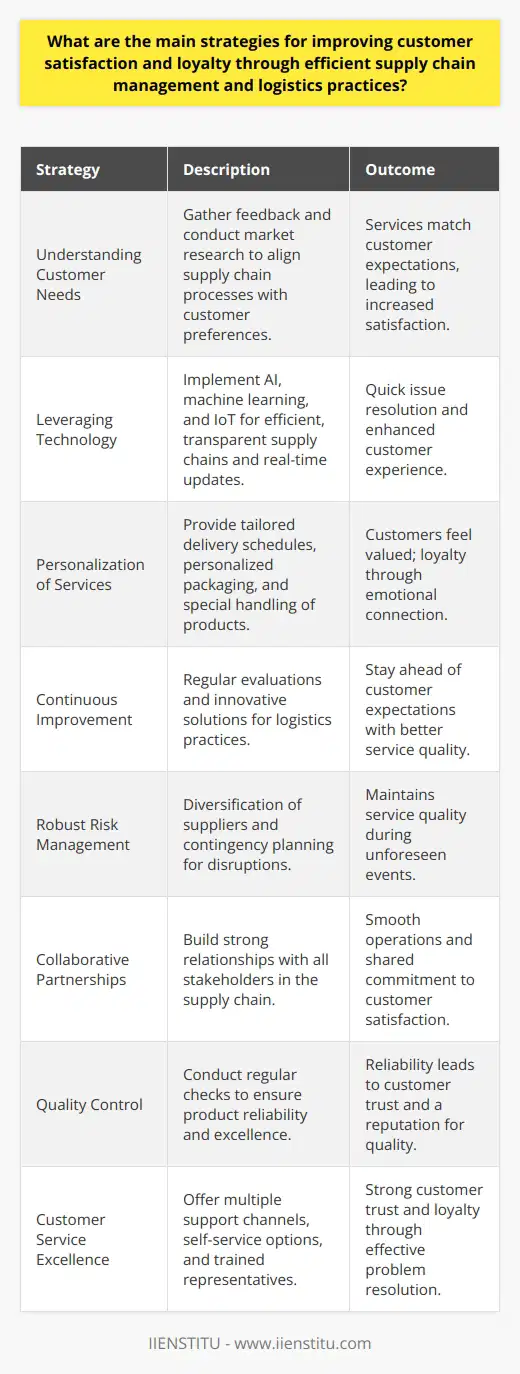
How can integrating state-of-the-art technologies in logistics operations lead to improved customer service and a more agile supply chain?
Technological Integration in Logistics Operations
Incorporating state-of-the-art technologies in logistics operations can greatly enhance customer service and create a more agile supply chain. A key element in this improvement process is the adoption of advanced analytical tools, such as artificial intelligence (AI) and machine learning. These technologies enable companies to generate actionable insights from vast amounts of data, consequently optimizing their logistics processes and decision-making.
Advantages of Real-Time Tracking
One of the major benefits of integrating advanced technologies in logistics operations is the capacity for real-time tracking. This allows companies to monitor the movement of goods more effectively, enabling transparent communication with customers regarding the delivery status of their orders. Ultimately, this transparency leads to increased customer satisfaction, as they are kept well-informed about their orders while having access to more accurate delivery information.
Automation and Robotics
In addition to tracking capabilities, automation and robotics are also transforming logistics operations. Automated machinery and robotic devices can significantly speed up the manual aspects of processing, packaging, and storage. By leveraging this technology, companies can reduce the potential for human error and free up valuable time for employees, who can then focus on more critical activities, such as managing customer relations or identifying new business opportunities.
Internet of Things (IoT)
The Internet of Things (IoT) also plays a pivotal role in improving logistics operations. IoT devices, such as sensors and smart tags, can continuously collect and transmit data about the movement and condition of goods. This information enables companies to optimize their warehouse storage, transportation routes, and inventory management, ultimately resulting in a more agile supply chain.
Predictive Analytics and Forecasting
Using predictive analytics and forecasting can help companies anticipate future trends and fluctuations in demand, further improving the agility of their supply chains. By analyzing historical data and market trends, these tools can predict potential areas of growth or decline, allowing companies to make well-informed decisions about resource allocation and inventory management. As a result, they can fulfil customer needs more effectively and respond to market changes more swiftly.
In conclusion, the integration of state-of-the-art technologies in logistics operations can lead to improved customer service and a more agile supply chain. By leveraging advanced analytical tools, real-time tracking, automation, IoT devices, and predictive analytics, companies can optimize their processes, make more informed decisions, and ultimately, enhance customer satisfaction.
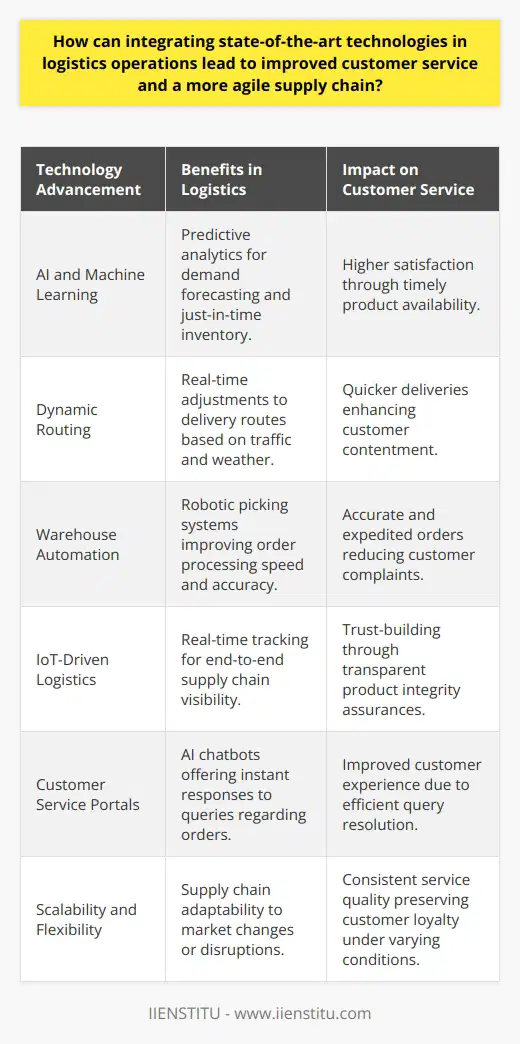
How does supply chain management improve customer service by streamlining inventory management and reducing excess stock?
Efficient Inventory Management
Supply chain management enhances customer service by optimizing inventory management processes, which ultimately results in a reduction of excess stock. Implementing effective supply chain strategies enables organizations to maintain an optimal balance of inventory, ensuring that products are readily available to meet customer demand. A well-managed inventory system prevents potential stock-out situations, which can negatively impact customer satisfaction and loyalty.
Reduction of Excess Stock
Excess stock can lead to several challenges, such as increased warehousing costs, products becoming obsolete, and reduced profitability. By streamlining the supply chain, organizations can continuously assess their inventory levels and make data-driven decisions to maintain the right amount of stock. This not only reduces carrying costs but also helps in increasing the product turnover rate, leading to better financial performance.
Data-Driven Decision Making
Utilizing advanced analytics in supply chain management allows organizations to forecast demand accurately, resulting in improved inventory management. Predictive analytics tools can identify patterns and trends in customer behavior, enabling better planning and replenishment processes. Adopting a data-driven approach to inventory management ensures that organizations can respond promptly to fluctuations in demand, thus reducing stock excesses while ensuring that customers receive the products they need in a timely manner.
Enhanced Supplier Collaboration
Effective supply chain management fosters collaboration between suppliers, manufacturers, and retailers, which plays a crucial role in reducing excess stock. By sharing real-time data and insights, businesses can work closely with their suppliers to manage inventory levels more efficiently. Improved collaboration leads to better communication, which helps in implementing just-in-time (JIT) inventory strategies that minimize the chances of overstocking and streamline order fulfillment.
In conclusion, supply chain management plays an integral role in improving customer service by streamlining inventory management and reducing excess stock. By adopting advanced analytics tools, effective supplier collaboration strategies, and data-driven decision-making, organizations can significantly enhance their inventory management processes, ultimately benefiting their customers through reliable product availability, prompt delivery, and minimized chances of stock-outs.

What are the four important aspects of logistics to customer service, and how can they be optimized to enhance overall satisfaction?
Aspects of Logistics in Customer Service
Effective logistics management plays a critical role in ensuring customer satisfaction. There are four main aspects of customer service that logistics can impact, and by optimizing them, overall satisfaction can be significantly enhanced. These aspects include delivery accuracy, lead time reduction, cost efficiency, and quality assurance.
Delivery Accuracy Improvement
Accuracy in delivering products to customers is a key element of logistics. Ensuring that orders arrive to the correct destination, on time, and in the right condition is crucial. By using advanced tracking systems, data analytics, and collaboration with supply chain partners, businesses can reduce errors, improve response times, and ultimately enhance customer satisfaction.
Lead Time Reduction Strategies
Shorter lead times are crucial to meet customer expectations and maintain a competitive edge. By implementing inventory management systems, utilizing technology such as automation, and enhancing communication across the supply chain, companies can streamline processes, reduce production times, and deliver products or services faster. In turn, this leads to improved customer satisfaction.
Cost Efficiency Maximization
Optimizing logistics processes can lead to reduced costs for both businesses and customers. Efficient supply chain management, by leveraging economies of scale, adopting eco-friendly practices, and implementing cost-effective transportation solutions, can result in significant savings. These cost reductions can be passed on to customers, leading to increased overall satisfaction.
Quality Assurance Enhancement
Maintaining high-quality products or services is crucial in meeting customer expectations. Logistics plays a key role in ensuring quality by controlling factors such as storage conditions, transportation integrity, and product handling. Adopting stringent quality control procedures along the logistic chain, investing in continuous improvement processes, and using data-driven decision-making can ensure product quality and drive customer satisfaction.
In conclusion, by focusing on delivery accuracy, lead time reduction, cost efficiency, and quality assurance, logistics management can have a profound impact on the overall customer experience. By optimizing these aspects, businesses can enhance customer satisfaction, ultimately leading to higher customer retention rates and increased profitability.
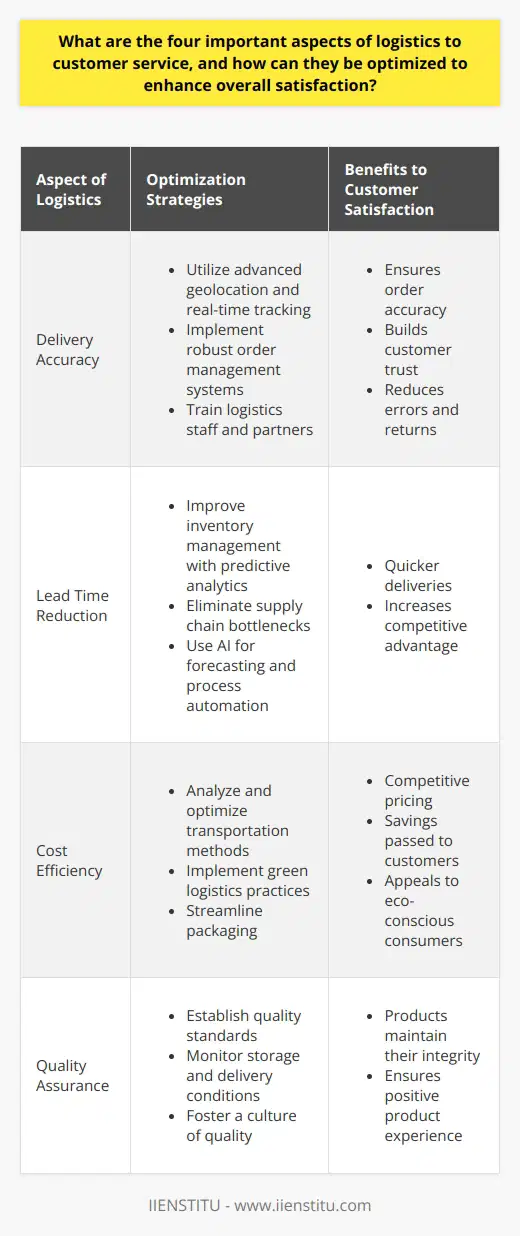
How can data analytics be used to optimize customer satisfaction for logistics activities by identifying trends and potential issues in advance?
Data Analytics and Customer Satisfaction
Identifying Trends
Data analytics enables logistics companies to analyze large volumes of data from various sources to identify trends in customer preferences and demands. By doing so, they can make strategic decisions to address these trends proactively, such as adjusting pricing, optimizing carrier selection, and improving delivery times to enhance customer satisfaction. For instance, seasonal peaks and valleys in demand can be identified and addressed by deploying resources more effectively to meet the fluctuating needs of customers.
Predictive Maintenance
Logistics companies can also use data analytics to predict potential issues with their equipment and infrastructure before they become critical. With predictive maintenance, logistics providers can schedule maintenance more effectively, reducing downtime and ensuring smooth operations. Consequently, this minimizes delays in fulfilling customer orders, which directly impact customer satisfaction levels.
Personalized Customer Experience
Data analytics can be employed to personalize customer experiences by analyzing individual preferences and requirements. By understanding customers' unique needs, logistics firms can offer tailored services, such as custom packaging, flexible delivery options, or optimized return processes. Personalization helps build loyalty and ensures a memorable experience, resulting in higher levels of satisfaction.
Real-time Insights
Leveraging real-time data allows logistics providers to monitor their operations continuously and identify any issues that might impact customer satisfaction levels. For example, detecting delayed shipments or potential bottlenecks in supply chains enables companies to take corrective actions promptly, ensuring timely delivery of goods and services. Moreover, real-time insights can be shared with customers to offer greater transparency and facilitate better communication, fostering trust and satisfaction.
Early Warning Systems
Finally, data analytics can be utilized to create early warning systems for potential issues in logistics activities. By monitoring vast amounts of data, anomalies can be detected that may signal potential disruptions or problems. Early identification of these issues allows logistics companies to develop contingency plans, mitigating risks and minimizing the negative impact on customer satisfaction.
In conclusion, data analytics offers logistics companies the opportunity to optimize customer satisfaction through trend identification, predictive maintenance, personalized experiences, real-time insights, and early warning systems. By proactively addressing potential issues and customizing services to meet customer needs, logistics providers can not only enhance satisfaction levels but also gain a competitive edge in the rapidly changing industry landscape.

How does logistics help in improving customer satisfaction by ensuring timely and accurate product deliveries?
Logistics and Customer Satisfaction
Effective logistics plays a crucial role in enhancing customer satisfaction through the timely and precise delivery of products. By optimizing various supply chain processes, logistics ensures products reach customers on or before the promised date. This punctuality not only meets but also exceeds customers' expectations, leading to higher satisfaction levels.
Supply Chain Optimization
Logistics involves the comprehensive management of transporting, warehousing, and distribution of goods from manufacturers to consumers. Through strategic supply chain management, companies can maximize efficiency and minimize costs. This optimization fosters swift and dependable delivery processes, which ultimately results in heightened customer satisfaction.
Inventory Management
Proper inventory management is essential for ensuring timely product deliveries. When companies maintain optimal stock levels, they can fulfill customer orders faster. Logistics professionals manage inventory by tracking product demand, mitigating stockouts or overstocks, and promoting accurate order fulfillment. These practices contribute significantly towards satisfying customers by reducing wait times and enhancing delivery reliability.
Technology Integration
The incorporation of technology in logistics operations enables companies to streamline their delivery processes further. For instance, employing advanced tracking systems and data analytics allows businesses to monitor shipments effectively, detect potential delays, and implement corrective actions to uphold punctual deliveries. Such technological innovation not only accelerates delivery times but also fosters transparency, encouraging customer trust and satisfaction.
Communication and Collaboration
Effective communication and collaboration among stakeholders involved in logistics processes ensure smooth, accurate, and prompt product deliveries. Improved information exchange between manufacturers, suppliers, distributors, and retailers facilitates the synchronization of supply chain operations. As a result, companies can fulfill customer orders more efficiently and accurately, significantly boosting their satisfaction levels.
In conclusion, logistics plays an indispensable role in promoting customer satisfaction by guaranteeing timely and accurate product deliveries. Through supply chain optimization, inventory management, technology integration, and effective communication, logistics caters to customer expectations by ensuring their orders are delivered promptly and correctly.
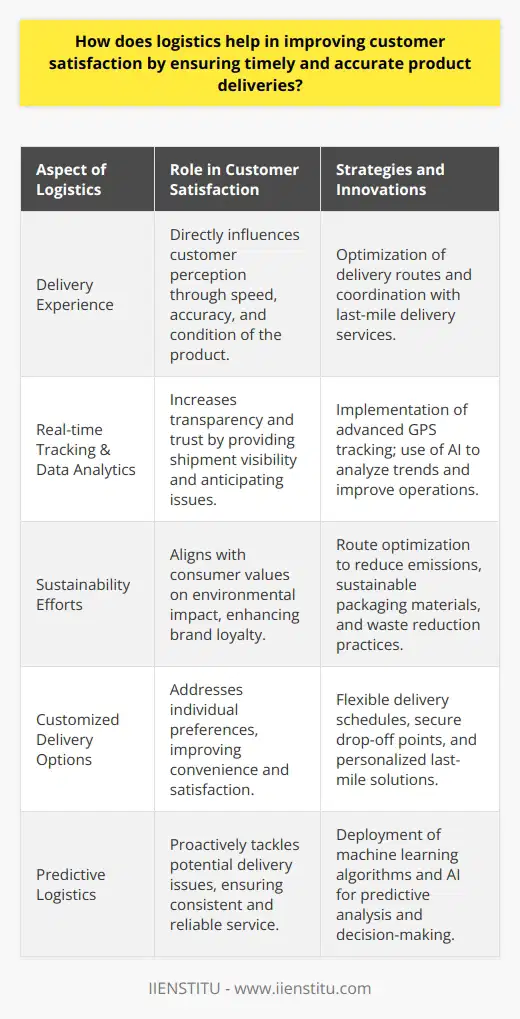
In what ways can a well-structured logistics management system contribute to a more positive customer experience through effective order fulfillment and returns management?
Effective Order Fulfillment
A well-structured logistics management system contributes to a positive customer experience by ensuring timely order fulfillment. By implementing efficient inventory management practices, businesses can ensure that products are readily available, leading to quicker order processing times. Additionally, optimizing distribution channels and transportation modes reduces the time taken for products to reach the end customer. This results in faster delivery and enhanced customer satisfaction.
Improved Accuracy and Reduced Errors
Efficient logistics systems employ automation and smart technology solutions to minimize order processing errors. Barcode scanning, inventory tracking software, and warehouse management systems enable accurate order picking and packing, reducing the chances of shipping incorrect items to customers. This increased precision ultimately leads to a more positive customer experience, as the clients receive exactly what they ordered without any delays or discrepancies.
Seamless Returns Management
Handling returns is an essential aspect of providing a positive customer experience, as it directly affects the customer's perception of the brand. A well-structured logistics management system incorporates an effective returns management process, which ensures that customers have a hassle-free experience when returning or exchanging products. This may include comprehensive return policies, streamlined reverse logistics procedures, and timely processing of refunds or exchanges. Prioritizing such practices builds customer trust and loyalty, positively impacting their overall experience.
Transparent Order Tracking
A fully integrated logistics management system allows for real-time order tracking, providing customers with accurate and transparent information regarding their order's status. By using effective communication channels, businesses can keep the customer informed about their order's progress and any potential delays or issues that may arise. Increased transparency instills trust and confidence in the brand, ultimately resulting in a more positive customer experience.
In conclusion, a well-structured logistics management system plays a vital role in creating a positive customer experience by ensuring the timely and accurate fulfillment of orders, seamless management of returns, and providing transparent order tracking. By focusing on these aspects, businesses can enhance customer satisfaction and foster long-term relationships, leading to increased brand loyalty and repeat business.

How does implementing a sustainable and efficient supply chain strategy contribute to enhancing customer service and fostering long-term loyalty?
Supply Chain Strategy and Customer Service
Implementing a sustainable and efficient supply chain strategy significantly contributes to enhancing customer service. A well-managed supply chain ensures timely delivery of products, maintains quality, and provides a seamless experience for customers. These factors build trust and satisfaction, encouraging customers to return for future purchases.
Environmental Responsibility and Brand Loyalty
A sustainable supply chain strategy also demonstrates corporate social responsibility. Consumers are increasingly concerned about environmental issues and seek to support businesses that prioritize sustainability. By adopting eco-friendly practices, companies showcase their commitment to tackling environmental problems, strengthening customers' perception and fostering long-term loyalty.
Efficient Management of Resources
Efficiency plays a critical role in managing resources effectively in a sustainable supply chain. Efficient use of energy, transportation, and materials helps minimize costs and environmental impact. Companies can pass on the benefits of reduced costs to customers in the form of competitive pricing, further improving customer loyalty.
Improved Product Quality and Selection
A sustainable supply chain strategy often translates into better product quality and a wider selection of offerings. By sourcing materials through sustainable means, businesses have access to superior quality inputs. This results in high-quality products that appeal to environmentally conscious consumers, enabling companies to differentiate themselves and attract a devout customer base.
Transparency and Accountability
Lastly, a sustainable supply chain strategy involves increased transparency and accountability. Companies that prioritize sustainability tend to communicate their achievements and goals openly. This transparency builds customer trust and allows consumers to appreciate the company's efforts in minimizing its environmental footprint.
In conclusion, implementing a sustainable and efficient supply chain strategy enhances customer service and fosters long-term loyalty by providing a seamless experience, addressing consumers' environmental concerns, ensuring efficient use of resources, offering superior product quality, and maintaining transparency in business operations. Adopting such a strategy ultimately results in attracting and retaining a dedicated, environmentally conscious customer base.



